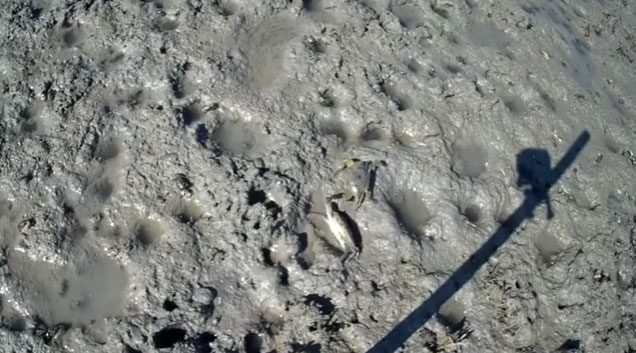When the tide recedes, blue crabs dig shallow holes in the mud to lie in wait for the fiddler crabs to pass by, then quickly dart out to catch their prey.
For the first time, scientists have recorded blue crabs (Callinectes sapidus) ambushing fiddler crabs (Minuca pugnax) in a salt marsh in Virginia, USA, as reported by IFL Science on August 17. The new study was published in the journal Ecology.

Blue crabs hunt by digging holes in the mud, creating shallow water pools and lying in wait.
When the tide goes out, blue crabs hunt by digging holes in the mud, forming shallow water pools and lying in wait. If they get too close, unsuspecting fiddler crabs risk becoming a delicious meal for them.
“It’s astonishing that an aquatic predator – living, feeding, breathing, and reproducing underwater – hunts out of the water. This is akin to crocodiles ambushing wildebeests in Africa,” explained Dr. David Johnson, the lead author of the study and an ecologist at the Virginia Institute of Marine Science at William and Mary University.
Aside from a few anecdotal pieces of evidence, the ambush behavior of blue crabs on fiddler crabs had never been documented. Previously, scientists knew that blue crabs preyed on fiddler crabs when the tide was high. However, when the tide was low, they assumed fiddler crabs hid in burrows while blue crabs fed on algae and carrion.
“Scientists were aware that blue crabs could venture a few steps onto land to catch fiddler crabs, then return to the water to tear apart and consume their prey. But the behavior we observed is different. Blue crabs do not chase their prey on land. They lie in wait, waiting for the prey to come to them,” Johnson noted.
Two weeks after the initial observations, Johnson and his research team returned to the marsh to learn more about the behavior of blue crabs. They found that 83% of juvenile crabs used mud holes, and the recorded videos helped conclude that they dug the holes themselves. The juvenile crabs did not stick to a specific hole but were willing to move between holes and force the owners of those holes to leave.
Additionally, the ambush strategy of blue crabs proved to be relatively successful. During 37 hours of filming, 11 out of 31 attacks ended with a victory for the blue crabs. They even attempted to steal fiddler crabs from each other.
Johnson believes that the blue crabs’ success is partly due to the assistance of another crab species. The purple marsh crab (Sesarma reticulatum), which feeds on grass, makes the marsh more open, allowing blue crabs to dig ambush holes more easily.
The team of experts plans to further study the behavior of blue crabs to see if this behavior is present in other aquatic species and to investigate how blue crabs camouflage themselves from predatory birds.


















































